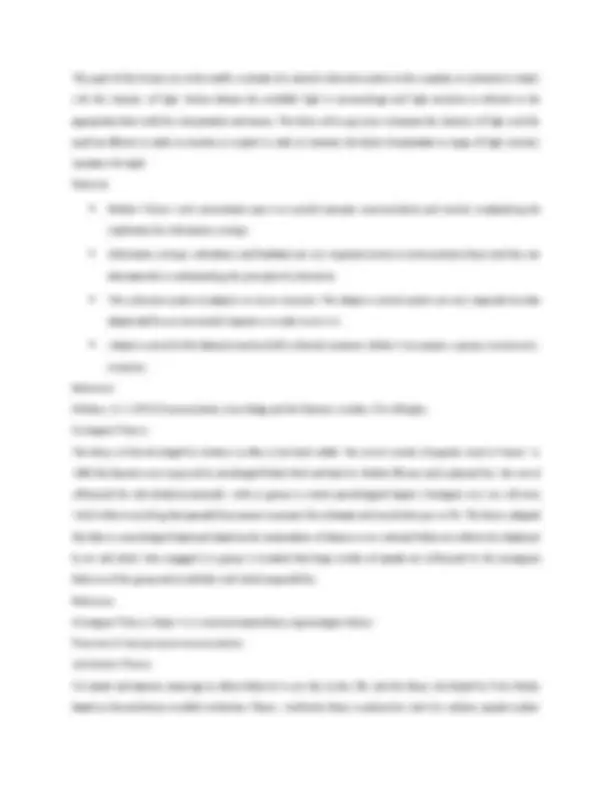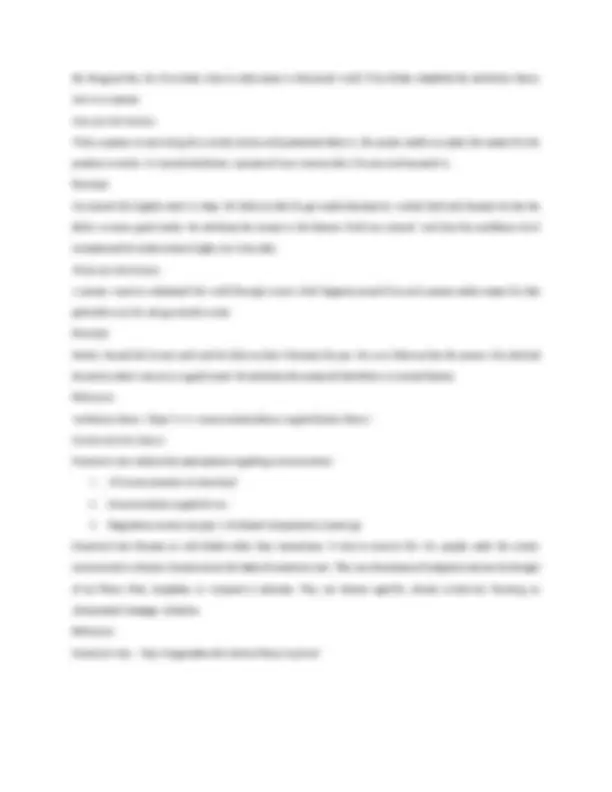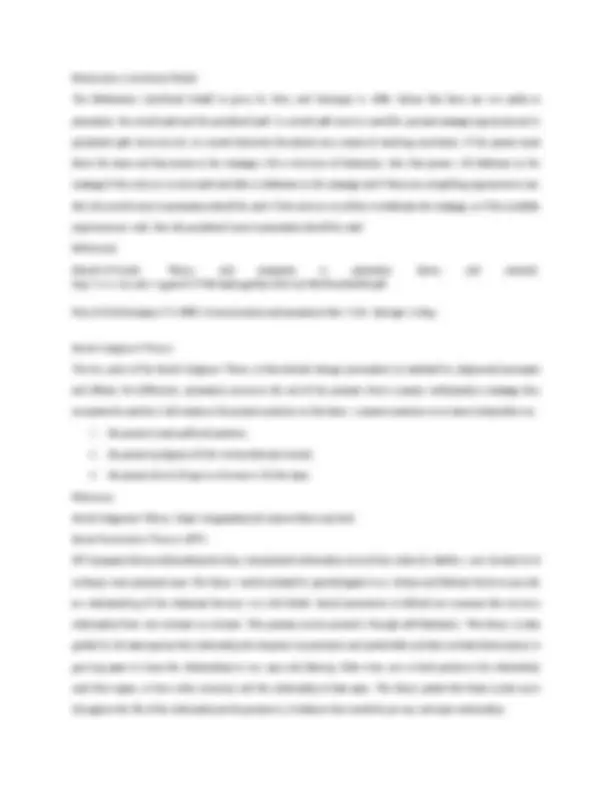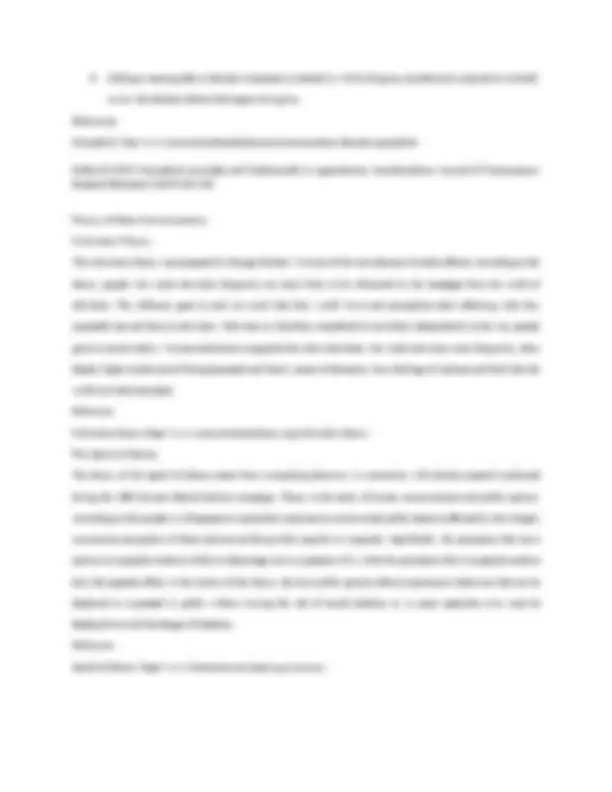






Study with the several resources on Docsity

Earn points by helping other students or get them with a premium plan


Prepare for your exams
Study with the several resources on Docsity

Earn points to download
Earn points by helping other students or get them with a premium plan
Community
Ask the community for help and clear up your study doubts
Discover the best universities in your country according to Docsity users
Free resources
Download our free guides on studying techniques, anxiety management strategies, and thesis advice from Docsity tutors
An insightful exploration of various communication theories, including Linear Theory, Cybernetic theory, Contagian Theory, and Interpersonal Communication. the basics of Shannon-Weaver Model, Cybernetics, and Contagian Theory, as well as specific theories within Interpersonal Communication such as Attribution Theory, Social Judgment Theory, Social Penetration Theory, and Uncertainty Reduction Theory. Each theory is explained in detail, providing valuable context and references for further study.
Typology: Study notes
1 / 8

This page cannot be seen from the preview
Don't miss anything!





Communication Theories According to Communication includes all aspects involved in the creation, export, import, and processing of artefacts used to link objects in the world. The study of communication encompasses all features of a communication system, Communication phenomena have been a central means of major transformations in the world. When it first appeared, the telegraph was described as an instrument of “the age of instant global communication.” In the 20 th^ century, Early Bird the world first’s satellite, was the start of “a massive global revolution in the 1960s. Current digital transmission technologies have had a “significant impact on human interaction and hold promise to further increase humankind’s ability to overcome constraints on communication imposed by time, location and distance. Theories of Communication ✓ Linear Theory or Mathematical Theory ✓ Cybernetic theory ✓ Contagian Theory ✓ Theories of interpersonal communication ▪ Attribution theory ▪ Elaboration likelihood theory ▪ Social judgment theory ▪ Social penetration theory ▪ Uncertainty reduction theory ▪ Constructivism ✓ Theory of Group communication ▪ Group think theory ✓ Theory of Mass communication ▪ Cultivation theory ▪ Spiral of silence theory Mathmatical Theory of Communication - Shannon and Weaver represents the communication process in their book entitled ‘The Mathmatical Theory of Communication’. Shannon-Weaver theory of communication was primarily designed to improve technical communication, but was later used to describe different fields of communication. Theory given by Shannon-Weaver includes the following concepts: sender, encoder, channel, decoder, receiver and feedback. Furthermore, there is also concept of noise included in the model, which goes through the channel and renders the message more difficult to understand by the receiver. Noise – Noise is a ‘black box’ concept. It pervades like an umbrella over the entire communication system, reducing the accuracy of communication and is responsible for miscommunication.
Basic categories of Noise (1) Internal Noise – refers to the uniqueness of human being that causes them to bring different perception to a message. These internal noises have become an entire field of study called, ‘semantics’- the study of meaning, of language and its effect on human being. In addition internal noise is also caused by an abnormal psychological or physiological state. (2) External Noise – refers to those environmental qualities that interfere with communication effectiveness, for ex. temperature, light, room size etc. Varieties of Noise (1) Non-mechanical Noise – This noise may eliminate completely if one is willing to make the required effort or pay the price for it. (2) Mechanical Noise – There is no remedy for this kind of noise. (3) Non-Verbal Noise – This can also occur because of contradictory mesvsages sent by the sender. For ex. if a politician while addressing an audience says he has plenty of time to speak, but very often sees his watch. References Al-Fedaghi,S.(2012) A Conceptual Foundation for the Shannon-Weaver Model of Communication. International Journal of Soft Computing. DOI: 10.3923/ijscomp.2012.12. Neeraj, Kumar (1997) Communication and Management. New Delhi, Gyan. Cybernetic theory The cybernetics model is developed by Norbert Wiener in electronics and Walter B.Cannon in biology. The term cybernetics is derived from the Greek ‘Kybernetes’ meaning of steersman, and one of the reason for choosing the term was that the steering mechanism of a ship was a good example of feedback mechanism. Cybernetics is the study of how open system exchange information with their environment and deals with the comparison of control and communication in man and machines. It is virtually important for two reason-its shows us what men have in common with the machines they create and how man himself think, reacts, behaves and learns. Primitive element of cybernetics System is called the Detector Governor, and Effector. These elements process information, maintain equilibrium or homeostasis, feedback behaviour and acquire knowledge of results.
the things as they do. Everybody tries to make sense in this social world. Fritz Heider classified the attribution theory into two types as: Internal Attribution When a person is motivating for a certain action and questioned about it, the person needs to explain the reason for the question or action. In Internal attribution, a person always wants to show him as much as positive. Example Jim scored the highest mark in class. He believes that he got marks because he worked hard and because he has the ability to score good marks. He attributes the causes in the factors which are internal. And thus his confidence level increases and he tends to score higher next time also. External Attribution A person wants to understand the world through events which happens around him and a person seeks reason for that particular event by using external events. Example Hendry Scored the lowest mark and he believes that it because the pen. He even believes that the person who checked his answer sheet was not in a good mood. He attributes the causes of this failure in external factors. Reference Attribution theory- https://www.communicationtheory.org/attribution-theory/ Constructivism theory Constructivism makes three assumptions regarding communication:
Elaboration Likelihood Model The Elaboration Likelihood Model is given by Petty and Cacioppo in 1986. claims that there are two paths to persuasion: the central path and the peripheral path. In central path receiver carefully process message arguments and in peripheral path receivers rely on mental shortcuts (heuristics) as a means of reaching conclusion. If the person cares about the issue and has access to the message with a minimum of distraction, then that person will elaborate on the message.If the receiver is motivated and able to elaborate on the message and if there are compelling arguments to use, then the central route to persuasion should be used. If the receiver is unlikely to elaborate the message, or if the available arguments are weak, then the peripheral route to persuasion should be used. References Danial,J.O’Keefe. Theory and prospects in persuation theory and research. http://www.uky.edu/~ngrant/CJT780/readings/Day%201/cjt780/OKeefe2004.pdf Petty,R.E.&Cacioppo,J.T.(1986). Communication and persuation.New York: Springer-verlag. Social Judgment Theory The key point of the Social Judgment Theory is that attitude change (persuasion) is mediated by judgmental processes and effects. Put differently, persuasion occurs at the end of the process where a person understands a message then compares the position it advocates to the person's position on that issue. A person's position on an issue is dependent on:
Groupthink The term “groupthink,” defined by psychologist Irving Janis in 1972, refers to how cohesive groups of people make and justify faulty decisions. People affected by groupthink usually feel pressured to conform to the views expressed by an influential group leader. Janis’s research uncovered eight symptoms that indicate group thinking:
displayed or expressed in public without running the risk of social isolation or, in some cases,that even must be displayed to avoid the danger of isolation. Reference Spiral of silence: https://www.britannica.com/topic/spiral-of-silence